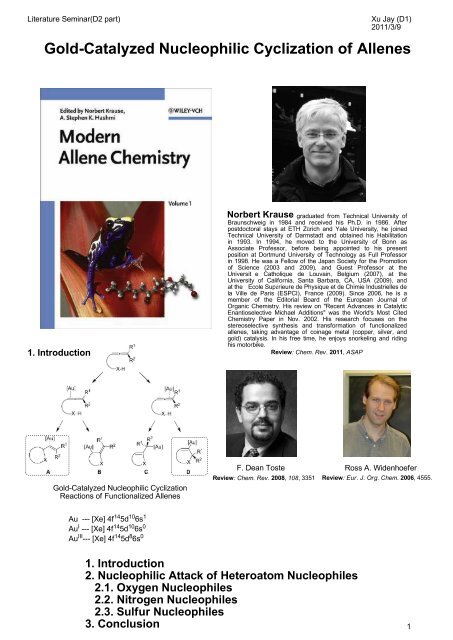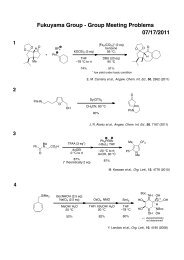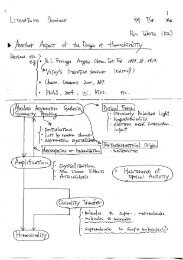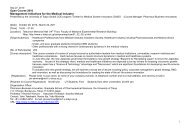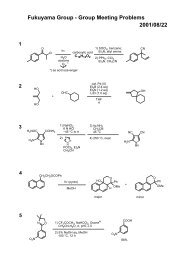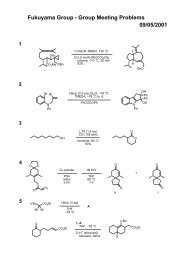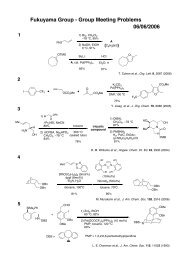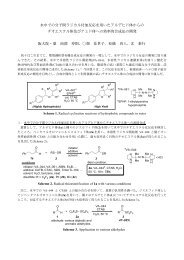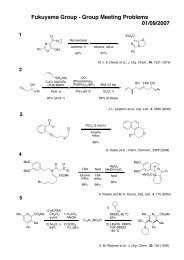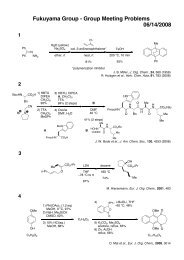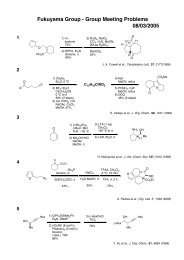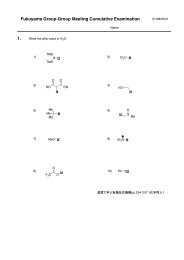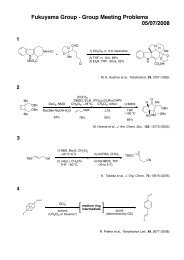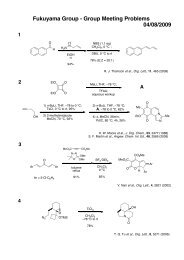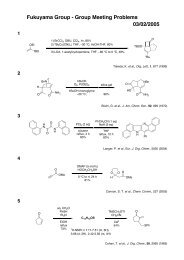Gold-Catalyzed Nucleophilic Cyclization of Allenes 1. Introduction 2 ...
Gold-Catalyzed Nucleophilic Cyclization of Allenes 1. Introduction 2 ...
Gold-Catalyzed Nucleophilic Cyclization of Allenes 1. Introduction 2 ...
You also want an ePaper? Increase the reach of your titles
YUMPU automatically turns print PDFs into web optimized ePapers that Google loves.
Literature Seminar(D2 part) Xu Jay (D1)<br />
2011/3/9<br />
<strong>Gold</strong>-<strong>Catalyzed</strong> <strong>Nucleophilic</strong> <strong>Cyclization</strong> <strong>of</strong> <strong>Allenes</strong><br />
<strong>1.</strong> <strong>Introduction</strong><br />
<strong>Gold</strong>-<strong>Catalyzed</strong> <strong>Nucleophilic</strong> <strong>Cyclization</strong><br />
Reactions <strong>of</strong> Functionalized <strong>Allenes</strong><br />
Au --- [Xe] 4f 14 5d 10 6s 1<br />
Au I --- [Xe] 4f 14 5d 10 6s 0<br />
Au III --- [Xe] 4f 14 5d 8 6s 0<br />
Norbert Krause<br />
graduated from Technical University <strong>of</strong><br />
Braunschweig in 1984 and received his Ph.D. in 1986. After<br />
postdoctoral stays at ETH Zürich and Yale University, he joined<br />
Technical University <strong>of</strong> Darmstadt and obtained his Habilitation<br />
in 1993. In 1994, he moved to the University <strong>of</strong> Bonn as<br />
Associate Pr<strong>of</strong>essor, before being appointed to his present<br />
position at Dortmund University <strong>of</strong> Technology as Full Pr<strong>of</strong>essor<br />
in 1998. He was a Fellow <strong>of</strong> the Japan Society for the Promotion<br />
<strong>of</strong> Science (2003 and 2009), and Guest Pr<strong>of</strong>essor at the<br />
Universit e Catholique de Louvain, Belgium (2007), at the<br />
University <strong>of</strong> California, Santa Barbara, CA, USA (2009), and<br />
at the Ecole Supérieure de Physique et de Chimie Industrielles de<br />
la Ville de Paris (ESPCI), France (2009). Since 2006, he is a<br />
member <strong>of</strong> the Editorial Board <strong>of</strong> the European Journal <strong>of</strong><br />
Organic Chemistry. His review on "Recent Advances in Catalytic<br />
Enantioselective Michael Additions" was the World's Most Cited<br />
Chemistry Paper in Nov. 2002. His research focuses on the<br />
stereoselective synthesis and transformation <strong>of</strong> functionalized<br />
allenes, taking advantage <strong>of</strong> coinage metal (copper, silver, and<br />
gold) catalysis. In his free time, he enjoys snorkeling and riding<br />
his motorbike.<br />
Review: Chem. Rev. 2011, ASAP<br />
F. Dean Toste Ross A. Widenhoefer<br />
Review: Chem. Rev. 2008, 108, 3351 Review: Eur. J. Org. Chem. 2006, 4555.<br />
<strong>1.</strong> <strong>Introduction</strong><br />
2. <strong>Nucleophilic</strong> Attack <strong>of</strong> Heteroatom Nucleophiles<br />
2.<strong>1.</strong> Oxygen Nucleophiles<br />
2.2. Nitrogen Nucleophiles<br />
2.3. Sulfur Nucleophiles<br />
3. Conclusion<br />
1
2. <strong>Nucleophilic</strong> Attack <strong>of</strong> Heteroatom Nucleophiles<br />
2.<strong>1.</strong> Oxygen Nucleophiles<br />
2.<strong>1.</strong><strong>1.</strong> Isomerization <strong>of</strong> Allenyl Ketones : synthesis <strong>of</strong> multisubstituted furans<br />
The f irst gold-catalyzed addition <strong>of</strong> a heteroatom nucleophile<br />
Hashmi, A. S. K. et al. Angew. Chem., Int. Ed. 2000, 39, 2285.<br />
1 2 3<br />
<strong>Gold</strong>(III) porphyrin-catalyzed cycloisomerization<br />
Che, C.-M. et al. Org. Lett. 2006, 8, 325.<br />
0.5 h<br />
<strong>Gold</strong> -allene complex<br />
Widenhoefer, R. A. et al.Organometallics 2010, 29, 4207.<br />
=<br />
In contrast to other transition metals :<br />
shorter reaction times<br />
milder conditions<br />
(lower catalyst loadings)<br />
5<br />
D<br />
C<br />
>1 week (silver)<br />
1 h (palladium)<br />
1 min (gold)<br />
The formation <strong>of</strong> the undesired dimerization product 3 (which is<br />
also generated in the corresponding silver-catalyzed cyclization)<br />
is a serious drawback.<br />
4a 5a 7a<br />
7a<br />
The Au(III) catalyst 6 is highly reactive and can be recovered and<br />
reused in up to nine consecutive runs with no appreciable loss <strong>of</strong><br />
reactivity or decrease <strong>of</strong> yield.<br />
The employment <strong>of</strong> CF 3CO 2H and a temperature <strong>of</strong> 60°C for the<br />
cycloisomerization reaction is essential.<br />
a rapid irreversible demetalation step resulting from unfavorable<br />
steric interactions between the porphyrin ring and the newly formed<br />
furyl moiety.<br />
The active gold species is coordinated to the "distal" double bond<br />
<strong>of</strong> the allene<br />
A<br />
B<br />
4<br />
7a<br />
2
Br<br />
<strong>Cyclization</strong> <strong>of</strong> haloallenyl ketone<br />
Gevorgyan, V. et al. J. Am. Chem. Soc. 2005, 127, 10500.<br />
J. Am. Chem. Soc. 2008, 130, 6940.<br />
H<br />
entry<br />
1<br />
2<br />
3<br />
4<br />
5<br />
Br<br />
H<br />
O<br />
C8H17 cat.<br />
rt H O<br />
+<br />
C8H17 Br O C8H17 1a 2a 3a<br />
cat.(mol %)<br />
CuCl (10)<br />
AuCl 3 (1)<br />
AuCl 3 (1)<br />
Au(PPh 3)Cl (1)<br />
Au(PEt 3)Cl (1)<br />
solvent time<br />
toluene<br />
toluene<br />
THF<br />
toluene<br />
toluene<br />
1 day<br />
5 min<br />
5 min<br />
9 h<br />
9 h<br />
path A path B<br />
4a 1a<br />
6a<br />
5a 8a<br />
7a<br />
[1,2]-H-shift<br />
2a 3a<br />
GC yield, %(2a:3a)<br />
29 (2a only)<br />
86 (95:5)<br />
78 (5:95)<br />
ND (16:85)<br />
ND (
Au(III)-catalyzed 1,2-Si migration in allenes<br />
Gevorgyan, V. et al. J. Am. Chem. Soc. 2010, 132, 7645.<br />
2.<strong>1.</strong>2. Isomerization <strong>of</strong> hydroxyallenes : formation <strong>of</strong> chiral heterocycles<br />
alkyl-substituted -hydroxyallenes Krause, N. et al. Org. Lett. 2001, 3, 2537.<br />
(7~10 mol %)<br />
6 7<br />
11<br />
Synthesis 2002, 1759.<br />
10<br />
5-endo-cyclization<br />
hydroxyallenes substrates with phenyl or electron-rich aromatic substituents<br />
entry<br />
1<br />
2<br />
3<br />
4<br />
5<br />
4<br />
Krause, N. et al. Synlett 2007, 1790.<br />
cat.(mol %)<br />
AuCl 3 (2)<br />
AuCl (2)<br />
AuCl 3 (2.5)<br />
AuCl (2.5)<br />
AuCl 3 (1)<br />
5<br />
Potential energy surfaces for the AuCl3-catalyzed cycloisomerization<br />
<strong>of</strong> allenes 4 (R = H)<br />
kinetically more favorable 1,2-Si migration over the 1,2-H shift<br />
led to the product complex 2-AuCl 3.<br />
12a 13a<br />
additive (%) temp. time (h)<br />
-<br />
-<br />
2,2-bipyridine (5)<br />
2,2-bipyridine (3.8)<br />
-<br />
rt<br />
rt<br />
rt<br />
rt<br />
-30°C<br />
the cyclization is accelerated in the presence <strong>of</strong> external proton donors(water, methanol)<br />
this suggests that the protodeauration <strong>of</strong> 10 is the rate-limiting step.<br />
1<br />
1<br />
1<br />
10<br />
2<br />
% yield(cis:trans)<br />
81 (75:25)<br />
85 (60:40)<br />
70 (>97:3)<br />
96 (95:5)<br />
92 (97:3)<br />
Proposed mechanism<br />
epimerization during the gold-catalyzed cyclization <strong>of</strong> phenyl-substituted -hydroxyallene 12 to dihydr<strong>of</strong>uran 13.<br />
AuCl 3 /CH 2Cl 2 epimerizes both the allene and the dihydr<strong>of</strong>uran.<br />
AuCl/CH 2Cl 2 epimerizes only the allene , but not the dihydr<strong>of</strong>uran.<br />
1<br />
1,2-Si~<br />
regiodivergent<br />
4 2<br />
a Isolated yield <strong>of</strong> product for reactions performed on 0.5 mmol scale.<br />
b Isolated yield <strong>of</strong> 2e for reaction performed in MeNO2.<br />
c Isolated yield <strong>of</strong> 2e for reaction performed with 1 mol % <strong>of</strong> catalyst.<br />
9<br />
8<br />
12 14 15<br />
cis-13 16<br />
trans-13<br />
zwitterionic intermediates<br />
(a planar benzyl cation<br />
substructure)<br />
epimerization prevented if<br />
the Lewis acidity <strong>of</strong> the gold catalyst is reduced so that the formation <strong>of</strong> zwitterionic intermediates 14/16 is disfavored;<br />
weakly coordinating solvents decreased the reactivity <strong>of</strong> the gold catalyst only slightly and led to an improved diastereoselectivity;<br />
original AuCl3/CH2Cl2 system at -30°C instead <strong>of</strong> room temperature.<br />
1,2-H~<br />
R 3<br />
R'Si<br />
R'Si<br />
R 3<br />
O<br />
O<br />
R 2<br />
R 2<br />
R 1<br />
R 1<br />
2<br />
3<br />
4
cycloisomerization <strong>of</strong> -dihydroxyallenes<br />
Krause, N. et al. Org. Biomol. Chem. 2007, 5, 1519.<br />
Tetrahedron 2009, 65, 1902.<br />
30 min<br />
1 2<br />
4<br />
The gold-catalyzed cycloisomerization <strong>of</strong> -dihydroxyallenes is not only stereoselective but also highly chemoselective.<br />
(because no product resulting from nucleophilic attack <strong>of</strong> the -hydroxy group was observed.)<br />
Cycloisomerization <strong>of</strong> -hydroxyallenes are <strong>of</strong>ten very slow, resulting in reaction times <strong>of</strong> several days.<br />
cycloisomerization <strong>of</strong> -hydroxyallenes (6-endo cyclization)<br />
Krause, N. et al. Org. Lett. 2006, 8, 4485.<br />
8a 9a<br />
10<br />
10<br />
exo-hydroalkoxylation <strong>of</strong> hydroxyallenes<br />
Widenhoefer, R. A. et al. J. Am. Chem. Soc. 2006, 128, 9066.<br />
14<br />
14<br />
11 12(5-exo) 13(6-exo)<br />
14 : Au[P(t-Bu) 2(o-biphenyl)]Cl<br />
3<br />
12 a 13 a<br />
Kocienski, P. J. et al. Angew. Chem., Int. Ed. 2009, 48, 5022.<br />
5 6<br />
7<br />
No trace <strong>of</strong> the 5-exo isomer could be detected<br />
Addition <strong>of</strong> pyridine or 2,2-bipyridine induced a remarkable increase <strong>of</strong> the<br />
reactivity.<br />
The yield was hardly affected by the solvent and the presence <strong>of</strong> silver salts.<br />
(leads to the formation <strong>of</strong> cationic gold species.)<br />
8a<br />
8b<br />
8c<br />
8d<br />
8e<br />
8f<br />
8 9<br />
Addition <strong>of</strong> N-iodosuccinimide (NIS) to the reaction mixture induces a tremendous<br />
acceleration, leading to the formation <strong>of</strong> the corresponding iodinated dihydropyran.<br />
This effect is probably caused by a very rapid iododeauration <strong>of</strong> a -gold<br />
intermediate(10, page 4) by NIS, which is activated by the gold catalyst.<br />
(NIS <strong>1.</strong>1-<strong>1.</strong>5 equiv.)<br />
Krause, N. et al. Eur. J. Org. Chem. 2010, 31<strong>1.</strong><br />
the regioselectivity <strong>of</strong> Au-catalyzed hydroalkoxylation<br />
depended strongly on the nature <strong>of</strong> the counterion.<br />
8b<br />
8a 10<br />
?<br />
5
Mechanism.<br />
1<br />
Au[P(t-Bu) 2(o-biphenyl)]Cl<br />
(5 mol%)<br />
2 3<br />
enantioselective exo-hydroalkoxylation <strong>of</strong> hydroxyallenes<br />
Widenhoefer, R. A. et al. Angew. Chem., Int. Ed. 2007, 46, 283.<br />
X<br />
OH<br />
n<br />
R<br />
[Au 2{(S)-4}Cl 2] (2.5 mol%)<br />
AgOTs (5 mol %)<br />
tolune, -20 C<br />
A B<br />
Toste, F. D. et al. Science 2007, 317, 496.<br />
entry<br />
1<br />
2<br />
3<br />
4<br />
O<br />
R<br />
(S)-4<br />
1<br />
Mechanism.<br />
OH<br />
rac-9<br />
9<br />
9<br />
n-Pr<br />
cat.<br />
tolune, -20 C<br />
O<br />
H<br />
+<br />
n-Pr<br />
O<br />
n-Pr<br />
H<br />
6<br />
5.3<br />
(R,E)-10 : (R,Z)-10 = <strong>1.</strong>5:1<br />
(28% ee) (39%ee)<br />
In the major pathway, complexation <strong>of</strong> Au to the Si face<br />
<strong>of</strong> the C4=C5 bond <strong>of</strong> rac-9 would form Au-allene complexes<br />
(Si,S)-I and (Si,R)-I.<br />
The minor enantiomers (S,Z)-10 and (S,E)-10 would be<br />
formed through outer-sphere cyclization <strong>of</strong> the Au-allene<br />
complexes (Re,S)-I and (Re,R)-I.<br />
[a] Ratio <strong>of</strong> isomers refers to trans/cis or E/Z. [b] Combined yield <strong>of</strong> all diastereomers with<br />
>95% purity. [c] For reactions that form two diastereomers, ee values are reported as<br />
trans/cis or E/Z. [d] Determination <strong>of</strong> the enantiomeric purity was complicated by the coelution<br />
<strong>of</strong> one enantiomer <strong>of</strong> (E)-6 with one enantiomer <strong>of</strong> (Z)-6 in HPLC. [e] Yield determined by 1H<br />
NMR analysis with reaction carried out in [D8]toluene.<br />
13a 14b 13 14<br />
ligand (L)<br />
(R)-3,5-xylyl-BINAP<br />
(R)-3,5-xylyl-BINAP<br />
(R)-DTBMSegphos<br />
dppm<br />
15<br />
X yield (%) ee (%)<br />
BF 4<br />
OPNB<br />
BF 4<br />
15<br />
68<br />
89<br />
79<br />
76<br />
0<br />
8<br />
2<br />
65<br />
(S,S)-DIPAMP<br />
The use <strong>of</strong> chiral counterions, rather than chiral neutral ligands, could<br />
provide high enantioselectivity in additions <strong>of</strong> oxygen nucleophiles to allenes.<br />
Neither noncoordinating (BF 4) nor more coordinating (OPNB) counterions<br />
associated with dicationic chiral bisphosphine(digold) species induced<br />
significant enantioselectivity in the cyclization.<br />
Chiral Binol-derived phosphoric acid 15 in conjunction with the<br />
dppm ([bis(diphenyl)phosphino]methane) ligand proved optimal.<br />
The chiral counterion can be combined additively with chiral ligands to enable<br />
an asymmetric transformation that cannot be achieved by either method alone.<br />
For the terminal allene(Entry 8), the enantiomeric excess could be improved from 80 to 92%<br />
by using a chiral gold catalyst [(S,S)-DIPAMP](AuCl) 2 together with the chiral silver salt.<br />
4<br />
5<br />
more-polar solvents, such as nitromethane or acetone,<br />
gave significantly lower enantiomeric excess values.<br />
the less-polar benzene proved to be the optimal medium,<br />
providing the desired product in an exceptional 97% ee.<br />
These findings are consistent with an ion-pair model, in which<br />
the degree <strong>of</strong> enantioinduction depends on the proximity <strong>of</strong> the<br />
counteranion to the cationic gold center<br />
2<br />
3<br />
10<br />
10<br />
:<br />
1
2.<strong>1.</strong>3. Isomerization <strong>of</strong> allenic esters : formation <strong>of</strong> lactones<br />
cyclization <strong>of</strong> allenic esters<br />
Hammond, G. B. et al. J. Am. Chem. Soc. 2008, 130, 17642.<br />
The structure <strong>of</strong> 3 was determined by<br />
1 H, 13 C, and 31 P NMR spectroscopic data<br />
and X-ray crystallography <strong>of</strong> complex 3d.<br />
dual-catalytic C-C bond formation as an<br />
alternative to protodemetalation<br />
Blum, S. A. et al. J. Am. Chem. Soc. 2009, 131, 18022.<br />
6 5<br />
cyclization-oxidative alkynylation <strong>of</strong> allenic esters<br />
Gouverneur, V. et al. Org. Lett. 2010, 12, 4904.<br />
12a 13a 14a<br />
entry<br />
1<br />
2<br />
3<br />
4<br />
5<br />
3a<br />
3a<br />
In the presence <strong>of</strong> triflic acid or iodine, vinylgold compounds 3a undergo<br />
protodeauration or iododeauration to the corresponding butenolides.<br />
Thus, the mechanism <strong>of</strong> the gold-catalyzed cyclization <strong>of</strong><br />
allenic esters is similar to that proposed for -hydroxyallenes<br />
6<br />
1 A<br />
3<br />
6b 6h<br />
9<br />
The observed crossover is consistent with the intermediacy <strong>of</strong> 10 and 11<br />
followed by intermolecular transmetalation and reductive elimination.<br />
R<br />
Ph<br />
2-MeC 6H 4<br />
3-MeC 6H 4<br />
4-MeC 6H 4<br />
4-MeOC 6H 4<br />
12<br />
C<br />
94<br />
42<br />
72<br />
98<br />
88<br />
14<br />
D<br />
7<br />
8<br />
B<br />
5a 5b<br />
5h 5i<br />
12 13 48 h<br />
14<br />
yield (%) entry R yield (%)<br />
6<br />
7<br />
8<br />
9<br />
10<br />
5<br />
13<br />
15<br />
4-FC 6H 4<br />
4-CF 3C 6H 4<br />
4-NO 2C 6H 4<br />
H<br />
n-Pr<br />
78<br />
63<br />
45<br />
16<br />
28<br />
10<br />
11<br />
7
2.2. Nitrogen Nucleophiles<br />
2.<strong>1.</strong><strong>1.</strong> endo-selective hydroamination<br />
first intramolecular endo-selective hydroamination <strong>of</strong> allenes<br />
Krause, N. et al. Org. Lett. 2004, 6, 412<strong>1.</strong><br />
1 2<br />
cycloisomerization <strong>of</strong> allenic hydroxylamine or hydroxylamine ether<br />
Krause, N. et al. Angew. Chem., Int. Ed. 2009, 48, 6339.<br />
Different reaction rates in the endo cycloisomerization<br />
possible consequences for the cyclization <strong>of</strong> N-hydroxy-a-aminoallenes<br />
5 3<br />
4<br />
6 7<br />
8 10<br />
Proposed mechanism for the formation <strong>of</strong> cis-substituted dihydroisoxazoles<br />
coordination <strong>of</strong> the gold catalyst to the allenic double bond<br />
adjacent to the hydroxylamine moiety affords complex A<br />
complex A undergoes a 5-endo cyclization to the zwitterionic<br />
species B.<br />
the bulky gold moiety is preferentially situated trans to the group R3<br />
the diminished reactivity <strong>of</strong> unprotected aminoallene is probably due<br />
to deactivation <strong>of</strong> the gold catalyst by the Lewis-basic amino group.<br />
An oxygen atom <strong>of</strong> the protecting group could stabilize the<br />
zwitterionic complex C by coordination, and the cyclization<br />
would proceed with partial isomerization (via single bond rotation)<br />
to complex D, leading to a diminished diastereoselectivity.<br />
all cycloisomerizations proceeded with exclusive 5-endo regioselectivity.<br />
6a<br />
allenic substrates in which the heteroatom<br />
positions were exchanged.<br />
cyclization proceeded by the nucleophilic attack <strong>of</strong> the nitrogen atom<br />
afforded a mixture <strong>of</strong> the 3,6-dihydro-1,2-oxazine and the 4,5-dihydroisoxazole<br />
8a 6-endo 9a 5-endo 10a<br />
highly regioselective cyclization <strong>of</strong> the allenic hydroxylamine ether 8a to<br />
4,5-dihydroisoxazole 10a could be achieved in the presence <strong>of</strong> cationic gold(I)<br />
complexes<br />
10(cis)<br />
7a<br />
9a 10a<br />
9a/10a<br />
5-endo cyclization<br />
8<br />
8
2.<strong>1.</strong>2. exo-selective hydroamination<br />
exo-selective hydroamination <strong>of</strong> N-allenyl carbamates<br />
Widenhoefer, R. A. et al. J. Am. Chem. Soc. 2006, 128, 9066.<br />
Au[P(t-Bu) 2(o-biphenyl)]Cl<br />
(5 mol%)<br />
1 2<br />
Widenhoefer, R. A. et al. J. Am. Chem. Soc. 2007, 129, 14148.<br />
Au[P(t-Bu) 2(o-biphenyl)]Cl<br />
(5 mol%)<br />
8 9<br />
dynamic kinetic enantioselective hydroamination(DKEH) <strong>of</strong> allenes<br />
formation <strong>of</strong> the E-alkene moiety <strong>of</strong> (R)-9 requires<br />
selective cyclization <strong>of</strong> gold-allene intermediate cis-I<br />
Au-catalyzed conversion <strong>of</strong> (S)-8 to (R)-9 presumably<br />
involves rapid and reversible formation <strong>of</strong> trans-I followed<br />
by irreversible cyclization <strong>of</strong> cis-I to form II.<br />
the transition state for C-N bond formation is destabilized<br />
to a greater extent by a cis arrangement <strong>of</strong> the carbamate<br />
moiety and n-propyl group (trans-I II) than by a cis<br />
arrangement <strong>of</strong> the Au[P(t-Bu)2-(o-biphenyl)] moiety and<br />
the n-propyl group (cis-I II).<br />
9
highly enantioselective hydroamination <strong>of</strong> allenes<br />
Toste, F. D. et al. J. Am. Chem. Soc. 2007, 129, 2452.<br />
the remaining coordinated counterion was crucial for stereoinduction.<br />
replacing chloride with a larger coordinated counterion could further increase the transmission <strong>of</strong> chiral information.<br />
enantioselective hydroaminations and hydroalkoxylations <strong>of</strong> allenes with hydroxylamines and hydrazines<br />
Toste, F. D. et al. Angew. Chem., Int. Ed. 2010, 49, 598.<br />
10
2.3. Sulfur Nucleophiles<br />
cycloisomerization <strong>of</strong> -thioallenes<br />
Krause, N. et al. Angew. Chem., Int. Ed. 2006, 45, 1897.<br />
11
3. Conclusion<br />
(1) For carbophilic activation with Au(I), the reactivity and selectivity<br />
<strong>of</strong> cationic Au(I) complexes may be tuned by switching the ligand.<br />
Biphenyl-substituted phosphines ligands have repeatedly been<br />
observed to induce greater reactivity and modulate selectivity<br />
among competing reaction pathways.<br />
(b) The stability <strong>of</strong> Au(III) catalysts may be greatly improved with<br />
N-donor ligands. In some cases, the reactivity <strong>of</strong> the Au(III) center may<br />
be attenuated. Such ligands have also been successfully employed<br />
with Au(I) precatalysts in oxidation and group transfer reactions.<br />
Corma, A. et al. Angew. Chem., Int. Ed. 2007, 46, 1536.<br />
[Au I ] [Au III ]<br />
(54%)<br />
The homogeneous catalysis studies show us that Au I ,<br />
which has the same d 10 electronic configuration as Pd<br />
metal and Cu I , is active and very selective for performing<br />
the Sonogashira reaction.<br />
Au III does not catalyze the cross-coupling reaction but<br />
does catalyze the homocoupling condensation.<br />
12


